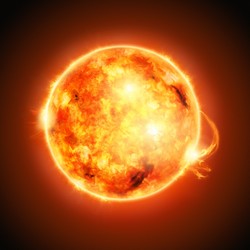The seismology of stars
Some stellar oscillations, so-called gravity modes, manage to travel all the way to the centre of a star. These are the most interesting scientifically, as they allow investigation of the properties of stellar cores. Two space missions capable of detecting them have recently been in operation: CoRoT, launched in 2006, and Kepler, launched in 2009. The PROSPERITY (Probing stellar physics and testing stellar evolution through asteroseismology) project used data from both missions. A highlight of this research was the discovery in a star with 8 solar masses of a chemically inhomogeneous zone surrounding the core, where hydrogen is fused into helium. A surprising level of mixing of the stellar material in that zone is implied. This mixing will cause the star to evolve more slowly than earlier models have predicted. Another important result is the discovery of mixed modes in red giant stars. Mixed modes probe both the core region and the outer layers simultaneously. The existence of mixed modes was anticipated in young stars, but they were also detected in red giants – large highly-evolved stars, like the Sun will become in about 5 billion years. Mixed modes have revealed two types of red giant. Some of them produce their energy from fusing hydrogen into helium in a zone surrounding their helium core, but others also fuse helium into carbon in the core. The most important discovery came from two years of uninterrupted Kepler data from red giants, leading to the detection of rotational splitting of mixed dipole modes. This shows that the cores of red giant stars typically rotate only 10 times faster than their envelopes, while models have predicted the ratio to be more than 100. Much stronger coupling between the core and envelope of evolved stars occurs than was anticipated. A number of beaming binaries were found. These are systems of two stars approaching the end of their nuclear lives, moving so close to each other in a joint orbit that tidal forces deform them. For one beaming binary it was shown that one star is a burned-out white dwarf while the other continues transforming helium into carbon.
Keywords
Asteroseismology, CoRoT, Kepler, stellar evolution, red giant, beaming binaries



